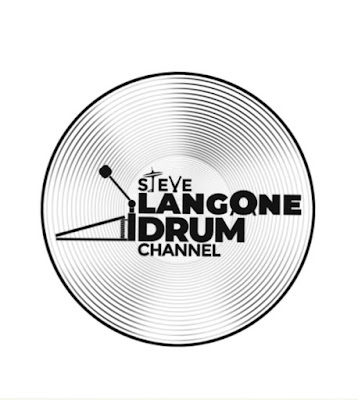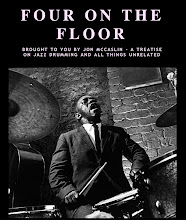I've been following Steve Langone via social media (Facebook, Instagram, etc.) and from his YouTube channel for some time now and I've always been very impressed with the content he consistently offers.
Steve is the author of three important self-published drum books: Advanced Rhythmic Concepts for the Modern Drummer, Volumes 1-3.
He was also very kind enough to take time out of his busy schedule to answer a few questions about his books.
He was also very kind enough to take time out of his busy schedule to answer a few questions about his books.
Steve Langone - The Four on the Floor Interview
"Advanced Rhythmic Concepts for The Modern Drummer"
March 2020
I have written three books, Advanced Rhythmic Concepts for the Modern Drummer: Volumes 1-3.
All the books are set up into two basic parts. One part has a series of “Grids”. The other part lists “Ways”of playing the “Grids”. So “Grids” and “Ways”.
A “Grid”is made up of a subdivision with different accents highlighting a polyrhythmic metric modulation. I have written in Konnakol syllables and recommend using pitch with your voice to mark the modulated time which I also call the secondary pulse. The subdivisions I use are eight notes, eighth note triplets and quarter note triplets.
The “Ways” of playing the “Grids” include Rudimental stickings, time ostinatos and orchestrations.
The purpose of my book is to help develop a stronger pulse and sense of time, independence, developing your ear using Konnakol and to develop chops and control using accents, subdivisions and groupings of rhythms. Singing the Konnakol is very useful. To open up your mind rhythmically.
A shorter answer is....
I combined my studies with Alan Dawson using Ted Reeds Syncopation book with odd groupings of triplets and eighth notes, using Konnakol syllables.
2) What was the motivation and inspiration for putting together your method?
My inspiration for writing my books was to help me become more familiar with and have more rhythmic control...control over different groupings of subdivision etc. and to strengthen my ability overall to be a better musician. Also to get my self to sing the Konnakol syllables on a regular basis with exercises that I was familiar with.
I wanted to work more on my pulse and having control over my quarter note. I also played (and still play) in bands that required me to be familiar with grouping of triplets, sixteenths and eighth notes in different ways.
Drummers and musicians that influenced me greatly in writing these books are Bill Stewart, Dan Weiss, Eric Harland, Miguel Zenon, Henry Cole, Antonio Sanchez, Danny Carey, Trilok Gurtu, Anika Niles, Dafnis Prieto, Vinnie Colaiuta, Tony Williams and Elvin Jones.
3) How does your book differ from other drum set method books currently on the market? What makes them unique?
My book differs from other books because I am using familiar rudimental and jazz exercises, but with different groupings of subdivisions and the use of Konnakol syllables.
I know this is a lot to explain, but once you go through a few “Grids”, you then can apply the rhythms you learn to the Ted Reed syncopation book. So my books stand on their own. You could spend years with one book, but you can also apply the concepts to the syncopation book. And the ultimate goal is to have freedom rhythmically and to be able to play what you hear, and play music. Again, the singing of the syllables helps a lot.
4) How do you recommend students and teachers approach working through your materials?
How I recommend teachers and students work through my books is to go slow and start with the basic rudiment sections which are the first sections listed in the books. I would also recommend when going through the time exercises to start with plain quarter notes on the cymbal and not play the standard jazz pattern. I would also recommend that the student or teacher play the exercises from the beginning of the measure and just add one note at a time sequentially. I would also recommend singing using the Konnakol syllables and the standard ways of counting triplets. Working on both ways of singing is helpful. I would also recommend if you’re interested in checking out my YouTube channel where I have demonstrated many of the grades and will continue to demonstrate them.
I humbly recommend not to make my books as the only thing a teacher or student practices or studies. I recommend studying my material for no more than a half hour per practice. Spend your time on learning tunes or different musical feels forms, etc. My books are more geared towards rudiments, independence, developing pulse and control, chops and phrasing in different ways.
5) What are some of the challenges of putting together a drum method book? What advice do you have for anybody potentially interested in publishing their own book?
I could not have put these books together without the help of my friend, musician, composer, teacher, saxophonist extraordinaire Jim Repa. I went to him with my sketches, my papers, my thoughts and my ideas every week for about a year. We actually had a mega book, then we edited it down. It was extremely helpful to have a friend who is super knowledgeable and fast with computers. We were a team, or I should say we are a team. During the writing of this book I had to practice my ideas on the drums and then brought them to Jim and he was able to get them in the computer very quickly using Sibelius. Once the book was complete and in Sibelius and the text was in Word, it was very easy to use Create Space to self publish. Create Space switched to Amazon and now it is called KDP (Kindle Direct Publishing) which publishes my books in paperback and digital formats. Volume three is not available in digital format yet, only in paperback.
My books are sold and printed on demand. That means you can order my book in the UK, throughout Europe and in North America and South America, even in Asia, and the book should get to you within 10 days to two weeks depending on where you are. It is pretty amazing. The downside of self publishing is that I am my own promotion machine and I rely on social media and word-of-mouth to sell my books. It did get a good review in Modern Drummer magazine and has been endorsed by Antonio Sanchez, John Ramsay (former head of the Berklee College of Music Percussion departmen) and many other drummers and non-drummers.
My advice is: if you have an idea for a book, go for it! It’s a great learning experience. It’s very time consuming but it’s rewarding. You learn a lot about yourself and about expressing your ideas. It’s great to have something in print that you can refer to, build upon, pass along and look back on. I highly recommend it.
Here are a few examples featuring ideas from the books:
To learn more about Steve, his series of books and what he's up to these days, check out his website: www.stevelangone.com






















No comments:
Post a Comment